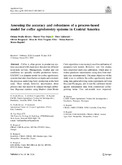| dc.contributor.author | Ovalle-Rivera, Oriana | |
| dc.contributor.author | Van Oijen, Marcel | |
| dc.contributor.author | Läderach, Peter | |
| dc.contributor.author | Roupsard, Olivier | |
| dc.contributor.author | Virginio Filho, Elias de Melo | |
| dc.contributor.author | Barrios, Mirna | |
| dc.contributor.author | Rapidel, Bruno | |
| dc.date.accessioned | 2020-10-26T22:06:11Z | |
| dc.date.available | 2020-10-26T22:06:11Z | |
| dc.date.issued | 2020 | |
| dc.identifier.uri | https://doi.org/10.1007/s10457-020-00521-6 | |
| dc.identifier.uri | https://repositorio.catie.ac.cr/handle/11554/9783 | |
| dc.description.abstract | Coffee is often grown in production systems associated with shade trees that provide different ecosystem services. Management, weather and soil conditions are spatially variable production factors. CAF2007 is a dynamic model for coffee agroforestry systems that takes these factors as inputs and simulates the processes underlying berry production at the field scale. There remain, however, uncertainties about process rates that need to be reduced through calibration. Bayesian statistics using Markov chain Monte Carlo algorithms is increasingly used for calibration of parameter-rich models. However, very few studies have employed multi-site calibration, which aims to reduce parameter uncertainties using data from multiple sites simultaneously. The main objectives of this study were to calibrate the coffee agroforestry model using data gathered in long-term experiments in Costa Rica and Nicaragua, and to test the calibrated model against independent data from commercial coffee-growing farms. Two sub-models were improved: calculation of flowering date and the modelling of biennial production patterns. The modified model, referred to as CAF2014, can be downloaded at https://doi.org/10.5281/zenodo.3608877. Calibration improved model performance (higher R2, lower RMSE) for Turrialba (Costa Rica) and Masatepe (Nicaragua), including when all experiments were pooled together. Multi-site and single-site Bayesian calibration led to similar RMSE. Validation on new data from coffee-growing farms revealed that both calibration methods improved simulation of yield and its bienniality. The thus improved model was used to test the effect of N fertilizer and shade in different locations on coffee yield. | es_ES |
| dc.language.iso | en | es_ES |
| dc.publisher | Springer, Nueva York (Estados Unidos) | es_ES |
| dc.relation.ispartof | Agroforestry Systems | es_ES |
| dc.rights | info:eu-repo/semantics/restrictedAccess | es_ES |
| dc.subject | SISTEMAS AGROFORESTALES | es_ES |
| dc.subject | CAFÉ | es_ES |
| dc.subject | EVALUACION | es_ES |
| dc.subject | SISTEMAS DE PRODUCCION | es_ES |
| dc.subject | SERVICIOS ECOSISTEMICOS | es_ES |
| dc.subject | FINCAS CAFETERAS | es_ES |
| dc.subject | RENDIMIENTO | es_ES |
| dc.subject | MODELACION | es_ES |
| dc.subject | PRODUCCION | es_ES |
| dc.subject | AMERICA CENTRAL | es_ES |
| dc.title | Assessing the accuracy and robustness of a process-based model for coffee agroforestry systems in Central America | es_ES |
| dc.type | Artículo | es_ES |


